Click on images to enlarge
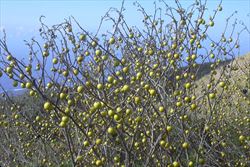
infestation in fruit (Photo: Forest and Kim Starr, USGS)
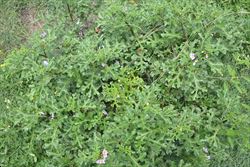
habit in flower (Photo: Sheldon Navie)
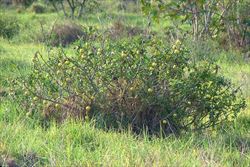
habit in fruit (Photo: Sheldon Navie)
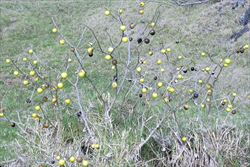
habit with older fruit (Photo: Forest and Kim Starr, USGS)
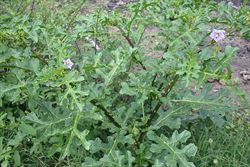
leaves and flowers (Photo: Sheldon Navie)
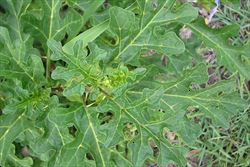
deeply-lobed leaves (Photo: Sheldon Navie)

close-up of large spines on upper leaf surface (Photo: Sheldon Navie)
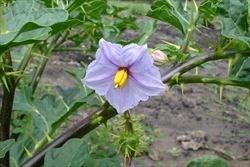
flower with spiny stems and sepals (Photo: Sheldon Navie)

close-up of purple flower with yellow stamens (Photo: Forest and Kim Starr, USGS)

close-up of green immature fruit with paler green markings (Photo: Sheldon Navie)
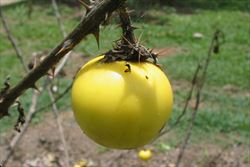
close-up of mature fruit (Photo: Sheldon Navie)
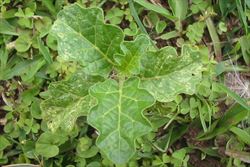
seedling (Photo: Sheldon Navie)
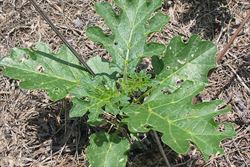
young plant (Photo: Sheldon Navie)
Scientific Name
Solanum linnaeanum Hepper & P.-M.L. Jaeger
Synonyms
Solanum hermanni SymonSolanum hermannii DunalSolanum sodomeum L. (misapplied)Solanum sodomeum L. var. hermannii (Dunal) Dunal
Family
Solanaceae
Common Names
Afghan thistle, apple of Sodom, apple-of-Sodom, bitter apple, black-spined nightshade, Dead Sea apple, devil's apple, poison apple, poison bush, poison weed, Sodom's apple, Sodom-apple
Origin
Native to southern Africa (i.e. Mozambique, Zimbabwe and South Africa).
Naturalised Distribution
Widely naturalised in southern and eastern Australia (i.e. in south-eastern and central Queensland, in the coastal districts of eastern New South Wales, in southern Victoria, in south-eastern South Australia and in the coastal districts of south-western Western Australia). Occasionally also naturalised in inland southern New South Wales, other parts of South Australia, and on Norfolk Island.
Naturalised overseas in New Zealand and on some Pacific islands (i.e. Fiji, New Caledonia and Hawaii).
Habitat
A weed of warmer temperate, sub-tropical and semi-arid regions that invades pastures, open woodlands, grasslands, roadsides, waste areas, disturbed sites, coastal environs and creeklines.
Habit
An upright (i.e. erect) or spreading (i.e. ascending) shrub usually growing 0.5-1.5 m tall, but occasionally reaching up to 2 m in height.
Distinguishing Features
- an upright or spreading shrub usually growing up to 1.5 m tall.
- its stems, leaf stalks, both leaf surfaces and flower stalks are all usually armed with stout prickles or spines (3-15 mm long).
- its alternately arranged leaves (2.5-15 cm long) are usually deeply lobed.
- its star-shaped purple flowers (15-35 mm across) have five petals and are borne singly or in small clusters near the tips of the branches.
- its globular berries (20-35 mm in size) are green with paler green or whitish mottling when young, and turn bright yellow when mature.
Stems and Leaves
The stems are green or purplish in colour when young, but turn brown or greyish and become woody with age. These stems are irregularly branched and are armed with numerous yellowish prickles or spines (3-15 mm long). Younger stems also have a covering of very small star-shaped (i.e. stellate) hairs.
The leaves (2.5-15 cm long and 1.5-8 cm wide) are alternately arranged along the stems and are borne on stalks (i.e. petioles) 4-27 mm long. They also have a sparse covering of tiny star-shaped (i.e. stellate) hairs, which are more abundant on their undersides. The leaf stalks (i.e. petioles) and both leaf surfaces are also armed with large prickles (3-13 mm long). These leaves are oblong to oval (i.e. elliptic) in outline, but are usually deeply lobed, with 3-5 lobes on each side of the leaf.
Flowers and Fruit
The star-shaped flowers (15-35 mm across) are usually purple, but sometimes they may be quite pale (i.e. almost white). These flowers have five petals (8-15 mm long) that are fused at the base and are borne singly, or in small clusters, near the tips of the branches on stalks (i.e. pedicels) 4-15 mm long. Each flower also has five green sepals (5-10.5 mm long) that are densely covered in small prickles (0.5-5 mm long) and five stamens with yellow anthers (5-6 mm long). The upper flowers in each cluster often only have male flower parts, while the lower flowers also have female parts (i.e. they are bisexual). The bisexual flowers have an ovary topped with a style (7.5-9 mm long) and stigma. Flowering occurs mostly during spring and summer.
The fruit are globular berries (20-35 mm in size) that contain numerous seeds. These fruit are green with a paler green or whitish-coloured mottling when young. They turn bright yellow when mature and eventually become brownish or blackish and wrinkled as they age. The light brown, brown, orange or black seeds (2-3.5 mm long) are rounded, but somewhat flattened.
Reproduction and Dispersal
This species reproduces only by seed.
These seeds are usually not spread very far from the parent plants, but the fruit may be dragged significant distances when the prickly stems become attached to animals or machinery.
Environmental Impact
Apple of Sodom (Solanum linnaeanum) is regarded as an environmental weed in Victoria and Western Australia. It was also recently listed as a priority environmental weed in two Natural Resource Management regions.
Legislation
This species is declared under legislation in the following states and territories:
- Tasmania: D - the importation or sale of this species is prohibited and measures to reduce its population in an area, eradicate it from an area, or restrict it to a particular area may be required. This species is declared as Solanum sodomaeum in Tasmania.
- Victoria: P1 - prohibited and must be eradicated or controlled (in the North East region only), and C5 - all reasonable steps must be taken to control the weed and prevent its spread (in the Glenelg, Port Phillip West, Port Phillip East, West Gippsland and East Gippsland regions).
- Western Australia: P1 - the movement of this species or its seeds is prohibited (in those parts of the state mentioned below), P2 - to be eradicated (in the City of Albany, Cranbrook, Denmark, Gnowangerup, Jerramungup local authority areas and in part of the Plantagenet local authority area), P3 - a weed which cannot be eradicated in the short term, but must be kept under 'control' (in the remainder of the Plantagenet local authority area only), and P4 - the weed must be 'contained' (in numerous local authority areas). See the Western Australian Department of Agriculture and Food Declared Plant List at http://www.agric.wa.gov.au/ for more detailed information about which areas are covered by these declarations.
Management
For information on the management of this species see the following resources:
- the Western Australian Department of Agriculture and Food information page on this species, online at http://www.agric.wa.gov.au.
Similar Species
Apple of Sodom (Solanum linnaeanum) is very similar to the native Narrawa burr (Solanum cinereum) and relatively similar to the introduced devil's apple (Solanum capsicoides). These species can be distinguished by the following differences:
- apple of Sodom (Solanum linnaeanum) usually has a low, spreading or upright habit and its younger stems are greenish or purplish in colour. Its upper leaf surfaces are green and its lower leaf surfaces are green and moderately or sparsely hairy. Its flowers are purple and its yellow or brown mature fruit are relatively large (20-35 mm across).
- Narrawa burr (Solanum cinereum) has a low, spreading habit and its younger stems are greyish-green in colour. Its upper leaf surfaces are green but its lower leaf surfaces are greyish-green and densely hairy. Its flowers are purple and its pale green to greenish-white mature fruit are relatively small (15-20 mm across).
- devil's apple (Solanum capsicoides) has a low, spreading habit and its younger stems are mostly green in colour. Its upper leaf surfaces are green and its lower leaf surfaces are also green and mostly hairless. Its flowers are white and its orange or reddish mature fruit are relatively large (20-35 mm across).
Apple of Sodom (Solanum linnaeanum) may also be confused with several other prickly native solanums with purple flowers (e.g. Solanum brownii, Solanum campanulatum, Solanum prinophyllum, Solanum pungetium, and Solanum lacunarium ).
Note: For a more in-depth key to distinguish between all of the solanums (Solanum spp.) present in eastern Australia, see the online key to the Solanum Species of Eastern Australia at http://delta-intkey.com/solanum/index.htm.

